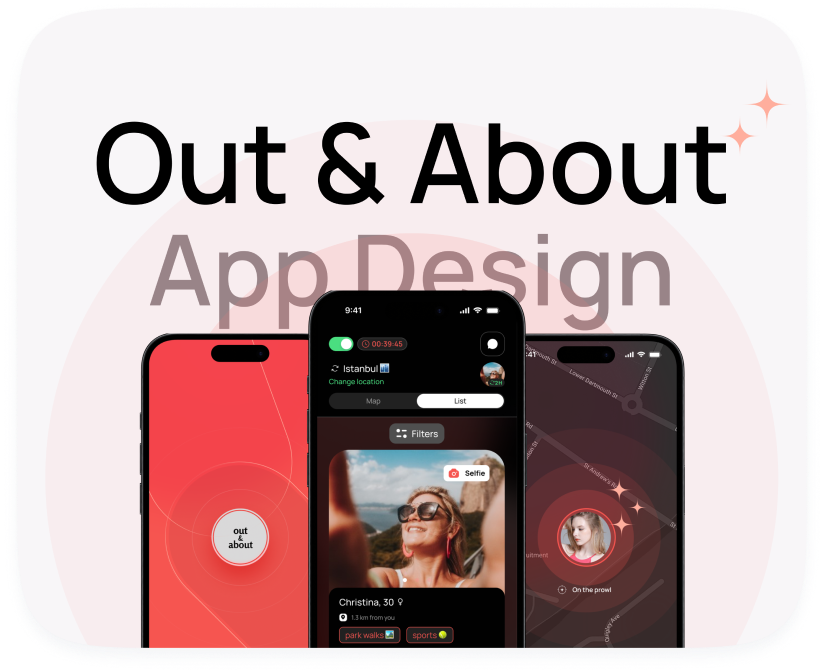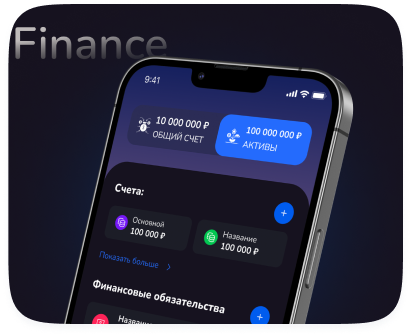
We build mobile apps





We work directly with every client
We deliver solutions with guaranteed results.

We build mobile apps






















It’s similar to buying a car at a dealership: you can go with the basic model, or choose a fully loaded version — it all depends on your needs and goals.

How to create YOUR OWN ChatGPT?

How to PROPERLY create a mobile app in 2024 | Step by step

You pay > We work > You receive the results. If you’re satisfied, you pay the next installment.
We need to have a call and discuss your specific requirements.
One thing we can say for sure: projects under 500,000 rubles are not feasible — we can’t deliver the required quality for less.
We launch, gather user feedback, and add new features that help you earn more from the app.
During development, I always design the architecture to make future updates and improvements easy and convenient.
Some apps perform better with influencer marketing, others through ad networks, and sometimes it’s even effective to buy a contact list and set up retargeting 😊
It all depends on your project’s specifics and is discussed personally.
How we can help:
- Set up ASO (App Store Optimization) and create an attractive app store page to drive free, organic installs.
- Help you develop the right promotion strategy tailored to your app.
- Share contacts of advertising experts I personally work with.
Спросить ChatGPT
The only ongoing cost is paying for the server (hosting).
You pay a subscription fee for the server. The more users your app has, the more server resources it consumes, and the higher the hosting costs.
At the early stages, when you have few users, the server will be FREE.
After that, the cost will gradually increase, but it remains affordable.
For example, an app with 100,000 users spent about $150 per month on hosting.
Cross-Platform App Development Services | iOS & Android
Reach a wider audience with efficient and cost-effective mobile app development solutions that work seamlessly on both iOS and Android platforms. Explore the benefits of cross-platform development and find the right technology for your project.
Introduction to Cross-Platform App Development
In today's mobile-first world, having a mobile application is crucial for businesses looking to connect with their customers. However, developing separate native applications for iOS and Android can be time-consuming and expensive. Cross-platform app development offers a compelling alternative, allowing you to create a single codebase that can be deployed on multiple platforms. This approach reduces development costs, accelerates time-to-market, and simplifies maintenance.
Understanding the Benefits of Cross-Platform Development
Choosing cross-platform development brings numerous advantages. Here's a detailed look at the key benefits:
Cost-Effectiveness
One of the most significant advantages is the reduction in development costs. Instead of maintaining two separate codebases for iOS and Android, you only need to manage one. This translates to lower development time, fewer resources, and reduced overall project expenses.
Faster Time-to-Market
With a single codebase, you can launch your app on both iOS and Android simultaneously. This significantly reduces the time it takes to reach your target audience, giving you a competitive edge in the market. A quicker launch also means faster feedback collection and iterative improvements.
Wider Audience Reach
By deploying your app on both major platforms, you can reach a significantly larger audience. This increased visibility can lead to higher user engagement, more downloads, and greater revenue potential.
Simplified Maintenance and Updates
Maintaining a single codebase simplifies the update process. When you need to fix a bug or add a new feature, you only need to make the change once, and it will be reflected on both platforms. This streamlines maintenance and reduces the risk of inconsistencies between the iOS and Android versions of your app.
Code Reusability
Cross-platform frameworks allow developers to reuse a significant portion of the code across different platforms. This not only saves time but also ensures consistency in the app's functionality and user experience.
Popular Cross-Platform Development Frameworks
Several frameworks are available for building cross-platform mobile applications. Each framework has its own strengths and weaknesses, making it crucial to choose the right one for your project. Here's an overview of some of the most popular options:
React Native
React Native, developed by Facebook, is a JavaScript framework for building native mobile apps. It allows developers to use their existing JavaScript knowledge to create high-performance applications that look and feel native on both iOS and Android. React Native uses native UI components, resulting in a smooth and responsive user experience. It also supports hot reloading, which allows developers to see changes in real-time without having to rebuild the entire app.
Flutter
Flutter, developed by Google, is a UI toolkit for building natively compiled applications for mobile, web, and desktop from a single codebase. Flutter uses Dart as its programming language and offers a rich set of pre-built widgets and tools. It's known for its fast performance, beautiful UI, and hot reload feature. Flutter's "everything is a widget" philosophy makes it highly customizable and flexible.
Xamarin
Xamarin, now part of the .NET platform, allows developers to build cross-platform apps using C#. Xamarin provides access to native APIs, allowing developers to create apps with native performance and UI. It's a good choice for developers who are already familiar with C# and the .NET ecosystem. Xamarin also offers Xamarin.Forms, a UI framework that allows developers to create a single UI that can be shared across iOS, Android, and Windows.
Ionic
Ionic is an open-source framework for building hybrid mobile apps using web technologies like HTML, CSS, and JavaScript. Ionic uses web views to render the app's UI, making it relatively easy to learn for web developers. While Ionic apps may not have the same level of performance as native apps, they are a good option for building simple, content-driven applications.
NativeScript
NativeScript is an open-source framework for building native mobile apps with JavaScript, TypeScript, or Angular. Unlike hybrid frameworks, NativeScript compiles to native code, resulting in better performance. It provides access to native APIs and allows developers to reuse existing web development skills.
Choosing the Right Cross-Platform Framework
Selecting the best cross-platform framework for your project depends on several factors, including your team's existing skills, the complexity of the app, performance requirements, and budget. Here's a guide to help you make the right choice:
Assess Your Team's Skills
Consider the programming languages and frameworks that your team is already familiar with. If your team has expertise in JavaScript, React Native or Ionic might be good choices. If they are proficient in C#, Xamarin could be a better fit. Choosing a framework that aligns with your team's skills will reduce the learning curve and accelerate development.
Consider the App's Complexity
For simple, content-driven apps, Ionic might be sufficient. For more complex apps with demanding performance requirements, React Native or Flutter are often better options. Xamarin is a good choice for apps that require access to native APIs and features.
Evaluate Performance Requirements
If performance is a critical factor, choose a framework that compiles to native code, such as React Native, Flutter, or Xamarin. Hybrid frameworks like Ionic may not offer the same level of performance as native apps.
Set a Budget
Different frameworks have different associated costs. Some frameworks are open-source and free to use, while others may require licensing fees. Factor in the cost of development tools, libraries, and third-party services when setting your budget.
Future Maintenance
Consider the long-term maintainability of your app. Choose a framework that is actively maintained and has a large and supportive community. This will ensure that you have access to updates, bug fixes, and community support in the future.
The Cross-Platform App Development Process
Developing a cross-platform app involves a similar process to native app development, but with some key differences. Here's a general overview of the typical stages:
Requirements Gathering
The first step is to gather detailed requirements for your app. This includes defining the target audience, key features, user interface (UI) design, and platform compatibility requirements. Thorough requirements gathering is essential for ensuring that the app meets your business objectives.
UI/UX Design
Create wireframes and mockups to visualize the app's user interface and user experience (UI/UX). Pay attention to the platform-specific design guidelines for iOS and Android to ensure a consistent and intuitive user experience. Ensure the design translates well across different screen sizes and resolutions.
Development
Write the code using your chosen cross-platform framework. Follow best practices for code organization, modularity, and testing. Use version control systems like Git to manage the codebase and collaborate effectively with your team. This is often the most lengthy and important stage.
Testing
Thoroughly test the app on both iOS and Android devices. Perform unit tests, integration tests, and user acceptance testing (UAT) to identify and fix bugs. Use emulators and simulators to test the app on different devices and screen sizes. Testing should also include performance testing to assure that the app behaves as expected under different workloads.
Deployment
Deploy the app to the App Store (for iOS) and Google Play Store (for Android). Follow the submission guidelines for each platform to ensure that your app is approved. Monitor the app's performance and user feedback after launch to identify areas for improvement.
Maintenance and Updates
Regularly maintain and update the app to fix bugs, add new features, and improve performance. Monitor user reviews and feedback to identify areas for improvement. Keep the app up-to-date with the latest platform updates and security patches.
The Future of Cross-Platform App Development
Cross-platform app development is constantly evolving, with new frameworks and technologies emerging regularly. As mobile platforms continue to mature, cross-platform development will become even more efficient and powerful. The trend towards code reuse and platform-agnostic development will likely continue, making cross-platform development an increasingly attractive option for businesses of all sizes.
Advancements in areas like WebAssembly and Progressive Web Apps (PWAs) are blurring the lines between native and web applications. These technologies offer the potential to deliver near-native performance and user experiences while maintaining the benefits of cross-platform development.
Furthermore, the increasing adoption of design systems and component-based architectures is making it easier to create consistent and reusable UI elements across different platforms. This will further streamline the development process and reduce the effort required to maintain cross-platform apps.
Considerations Before Choosing Cross-Platform
While cross-platform app development offers numerous benefits, it's important to consider its limitations before making a decision. One potential drawback is that cross-platform apps may not always offer the same level of performance as native apps. While frameworks like React Native and Flutter strive to provide near-native performance, they may still encounter performance bottlenecks in certain scenarios.
Another consideration is that cross-platform apps may require more effort to customize for each platform. While most frameworks provide tools for platform-specific customization, developers may need to write native code to achieve certain effects or access platform-specific features.
Finally, it's important to be aware of the potential for platform fragmentation. As new versions of iOS and Android are released, developers may need to update their cross-platform apps to ensure compatibility. This can add to the maintenance burden and require ongoing investment in development resources.
Table of Cross-Platform Frameworks
| Framework | Language | Pros | Cons | Best Use Cases |
|---|---|---|---|---|
| React Native | JavaScript | Native performance, code reuse, large community | Requires JavaScript knowledge, platform-specific customization may be needed | Complex apps with demanding performance requirements, apps that require access to native APIs |
| Flutter | Dart | Fast performance, beautiful UI, hot reload | Requires learning Dart, relatively new framework | Apps with visually rich interfaces, apps that require high performance |
| Xamarin | C# | Native performance, access to native APIs, code reuse | Requires C# knowledge, can be more complex to set up | Enterprise apps, apps that require access to native APIs, teams with C# expertise |
| Ionic | HTML, CSS, JavaScript | Easy to learn for web developers, large community, rapid development | Performance limitations, may not feel as native as other frameworks | Simple, content-driven apps, prototypes, web-based apps |
| NativeScript | JavaScript, TypeScript, Angular | Native performance, access to native APIs, code reuse | Steeper learning curve compared to Ionic, smaller community than React Native or Flutter. | Apps requiring native performance built with Javascript, Typescript, or Angular. |
Conclusion
Cross-platform app development is a valuable approach for businesses seeking to reach a wider audience, reduce development costs, and accelerate time-to-market. By carefully considering the various frameworks and technologies available, and by following a well-defined development process, you can create high-quality cross-platform apps that meet your business needs and delight your users. Selecting the right framework and understanding the nuances of each platform is critical for success. With the continued evolution of cross-platform technologies, the future looks bright for this versatile and efficient approach to mobile app development.






